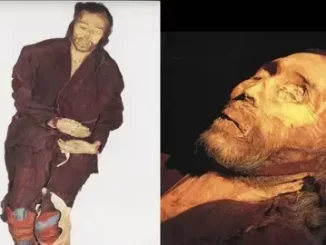The word ‘Celt’ refers to the people who spoke Celtic languages across Western and Central Europe between 1,200 BC and the 3rd century, and every Celtic nation had its own unique crafts, arts, and treasures. The Gauls of modern France left behind the famous La Tène-style ceremonial Agris Helmet that was crafted around 350 BC, and a 1st century AD ceremonial Celtic bronze helmet was found in the river Thames by Waterloo bridge in 1868, the so-called Waterloo helmet . Between 200 BC and 300 AD Danish Celts forged the silver Gundestrup cauldron, which is the largest known example of European Iron Age silver work ever discovered, and Early Bronze Age Irish Celts left behind a moon-shaped gold lunula that was discovered in Blessington, Co . Wicklow in 1945. This story, however, features a rare Celtic treasure that is currently on display in the National Museum of Prague in the Czech Republic – the flat-faced Mšecké Žehrovice head, also known as The Celtic Hero from Bohemia.
Carved in the 2nd or 3rd century BC, the Mšecké Žehrovice head was discovered by excavators in 1943 buried in a pit on a southwest corner of a square enclosure within the oppidum in Mšecké Žehrovice village in central Bohemia, Czech Republic. Sculpted from local Cretaceous limestone, the head was smashed into five pieces, four of which have been reassembled, and the whole object measures 234 mm (9.21 ins) high by 174 mm (6.85 ins) wide.
The Mšecké Žehrovice Hero, also known as the Mšecké Žehrovice Head and the Celtic Hero from Bohemia. (Miroslav Zachoval /CC BY 4.0)
According to a report on ‘Radio Prague International’ at the time this artifact was discovered archaeological Ivan Borkovský feared the Nazi occupiers would confiscate it, so he hid it until the end of the war. When he produced the head in 1945 it became quickly recognized as one of the greatest Celtic discoveries ever made in Bohemia.
Celtic Artisans Meant Everything They Carved
The man’s facial features and hairstyle are scratched into an almost flat surface. His neck is shaped like a classic Celtic torc necklace and his short hair is combed off the forehead while at the back of the head the hair is shaved off completely. The large owl-like oval eyes are contoured by a curvilinear eyebrow, which matches the style of the man’s curvilinear mustache. His mouth is formed with a slight downward bending line while his ears are shaped like lotus buds technique, a signature styling of La Tène style art, so named after the site of La Tène in Switzerland where thousands of Celtic objects were recovered from a lake in the early 19th century.
Side view of the Mšecké Žehrovice head, showing the hairstyle. (CeStu / CC BY 3.0)
‘The World History Encyclopaedia’ explains that Celtic sculptors used ‘stone, wood, and metals such as bronze, iron, gold, and silver for their arts and crafts… which were detailed with different colored glass (especially red), coral, shell, amber, semi-precious stones, and enamel.’ Craftsmen deployed a range of skills including engraving, punching, tracing, and repoussé (grooving the material from behind to create a relief on the other side), while compasses were used to mark faint lines , adding details. Many early Celtic sculptures reflect animal and human forms, and especially the heads of gods and heroes. Most often featuring people with over-sized lentoid eyes and bulbous noses with swept-back hair, Celtic art also includes items from day-to-day life like jugs and cauldrons, but also artifacts of war like chariots, weapons, and helmets.
It was originally assumed by archaeologists that the stone head represented a deity, however, Dr. Nela Venclová from the Institute of Archeology of the Czech Academy of Sciences says it is more likely that the face belongs to a real person. ‘We know that the Celts worshiped several gods, but that they also did not depict them. There seems to have been some sort of ban on this.’ This researcher believes the head represents a terrestrial ancestor-hero, perhaps the leader of a community, and that the tribe’s people ‘worshipped him through a sort of domestic cult.’
The Druidic Irish Connection
Dr. Nela Venclová closely studied the haircut featured on the Mšecké Žehrovice head and observed that the short forehead hairs are center-parted while the rear side depicts shaved hair. Therefore, the figure has ‘a completely shaved head with just the finely combed front hair being left, running from ear to ear.’ This particular hairstyle, a single frontal strip, can also be found on stone busts in 5th century Irish Churches dated to the time of Saint Patrick. When the Romans invaded Britain and Ireland in the 1st century the druids were high priests, teachers, and administrators of laws in Celtic culture and religion and their pagan practices survived long after they were drained in Central Europe. According to Dr. Venclová, when Saint Patrick converted the Irish to Christianity he also recorded the old druid laws of the land, and ‘basically, the druids turned into Christian hermits and monks.’
The transition in Ireland from druidic worship to Christianity meant many of the traditions of the old religion were carried forward into the new church of Ireland, including a very specific type of shaved hair tonsure worn by monks during ceremonial initiation rituals. While traditional Christian monks preferred the bald top style, druid converts wore a single strip of hair, just like the Celtic head of Mšecké Žehrovice.
In conclusion, finding this single strip of hair on a bald head in Old Irish Celtic culture suggests ‘the head of Mšecké Žehrovice depicts a druid,’ said Dr. Venclova. Thus, at the western and eastern extremes of the pre-Christian Celtic world a haircut unites the druidic leaders of both cultures, who lived on in stone carvings, both Bohemian and Irish.




